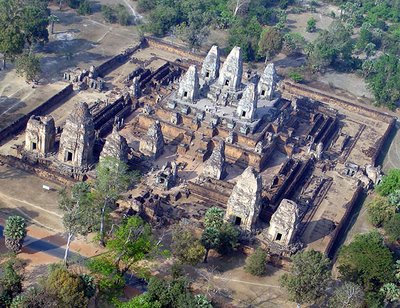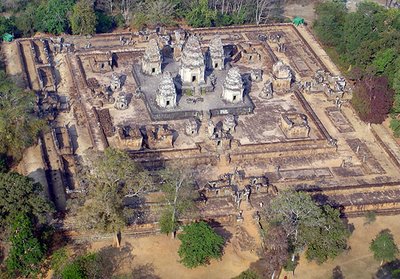Temple mountains
 Lets take a closer look at two of the temples I flew over on Tuesday morning in the two-seater microlite. The top one is Pre Rup, built in 961 and one of the most important temple mountains as it marks the transition from the pre-classic to the classic period of Angkor. It consists of two terraces, on the second of which is a three-tier pyramid. At the top, the central tower is flanked by four corner towers, all in brick. The central shrine would've housed a linga dedicated to Shiva. Below the upper tier are twelve smaller towers and on the ground floor, are another five larger brick towers, opening to the east and catching the rising sun as can be seen in the picture. One unusual feature of Pre Rup, where a sunset view across the surrounding ricefields is worth considering, is the presence of a sarcophagus, though some scholars debate this feature.
Lets take a closer look at two of the temples I flew over on Tuesday morning in the two-seater microlite. The top one is Pre Rup, built in 961 and one of the most important temple mountains as it marks the transition from the pre-classic to the classic period of Angkor. It consists of two terraces, on the second of which is a three-tier pyramid. At the top, the central tower is flanked by four corner towers, all in brick. The central shrine would've housed a linga dedicated to Shiva. Below the upper tier are twelve smaller towers and on the ground floor, are another five larger brick towers, opening to the east and catching the rising sun as can be seen in the picture. One unusual feature of Pre Rup, where a sunset view across the surrounding ricefields is worth considering, is the presence of a sarcophagus, though some scholars debate this feature. Also dedicated to Shiva, East Mebon was constructed in 952, so is older than Pre Rup and used to be in the centre of a huge, now dry, baray. Known for its elephant statues, East Mebon has three terraces with the five brick towers of the upper tier, open to the east with remains of stucco and some particularly fine lintels. Both temples are pre-cursors to the intricacies of the Banteay Srei style and the great temple constructions of Angkor Wat and Angkor Thom.
Also dedicated to Shiva, East Mebon was constructed in 952, so is older than Pre Rup and used to be in the centre of a huge, now dry, baray. Known for its elephant statues, East Mebon has three terraces with the five brick towers of the upper tier, open to the east with remains of stucco and some particularly fine lintels. Both temples are pre-cursors to the intricacies of the Banteay Srei style and the great temple constructions of Angkor Wat and Angkor Thom.Labels: East Mebon, microlite, Pre Rup

